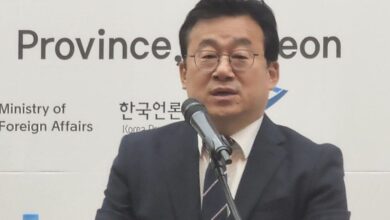Japan should play co-anchor role in helping ASEAN Connectivity Plus realize grand vision
By A.K.P. MOCHTAN
JAKARTA — With its intent for a people-oriented as well as a physically and institutionally well-connected ASEAN Community poised for realization in 2015, the Association of Southeast Asian Nations affirms its commitment to fulfill a long-cherished dream.
A set of road maps, blueprints, and master plans are in place. The mechanism and facility are expected to push intra-ASEAN integration efforts further, such as the ASEAN Connectivity Coordinating Committee and Infrastructure Fund.
Seamlessly connecting 10 nations is a gargantuan task, especially considering the obvious development gaps among some ASEAN members and the short time left. ASEAN is determined, however.
The agenda of the 19th ASEAN Summit held in Bali last month included ensuring progress toward the ASEAN Community.
Support is also pouring in. ASEAN’s dialogue and external partners are providing resources and expertise. ASEAN-led Leaders forums, including the Sixth East Asian Summit in Bali attended by U.S. President Barack Obama, endorsed ASEAN connectivity as a key area of cooperation.
All these lend to a jovial mood and positive prospects toward realization of the ASEAN connectivity.
Full impact of and maximum benefits from connectivity, however, will come only when integration transcends the ASEAN borders and connects them with countries in the greater East Asia region.
This broader, deeper, and synergetic interface is referred to as Connectivity Plus. It will be the core of a new and dynamic economic-politico-security architecture evolving in the region.
A master plan for ASEAN Connectivity Plus is awaited. In the meantime, a paramount challenge keeps nagging ASEAN, namely maintaining its centrality.
The question is whether ASEAN can remain in the driver’s seat and not be sidelined by the interests of other, larger powers as regional interconnectivity expands and deepens.
At the rate it is repeatedly emphasized in statements by senior officials and in various ASEAN documents, centrality appears to be sacred if not a phobia to ASEAN.
ASEAN’s centrality is in fact never in doubt. After more than 40 years of patient, persuasive diplomacy, ASEAN-led processes and mechanisms command respect and confidence among the international community.
The ASEAN code of conduct, modality and style of diplomacy and cooperation will most certainly continue to be predominant even in expanded, deepened ASEAN-Plus integration endeavors.
Indonesia, the incumbent chair of ASEAN, has been proactive in anticipating the centrality issue. Under Indonesia’s leadership, ASEAN leaders signed “Bali Concord III,” spelling out principles for ASEAN’s engagement in a global community of nations.
The concord stresses, among other things, ASEAN’s intent for a more coordinated and coherent position and enhanced capacity to contribute and respond to global issues.
Its centrality thus safely guarded, ASEAN should feel comfortable in co-opting external partners to co-anchor Connectivity Plus efforts. Optimizing partnership is especially important at this juncture when the ASEAN’s grand vision is so close to being realized.
Japan stands out as a co-anchor candidate. Japan-ASEAN partnership dates back nearly 40 years, starting with an informal dialogue in 1973. Japan is fully involved in all ASEAN-led dialogue processes and cooperation frameworks.
In May of this year Japan officially inaugurated a dedicated mission to ASEAN. It was the second Mission to ASEAN to have been established in Jakarta by a non-ASEAN member country, after the United States.
ASEAN-Japan strategic partnership covers a vast area of cooperation. It is encapsulated in the ASEAN-Japan joint declaration for “Enhancing Strategic Partnership for Prospering Together” and detailed further in the “Plan of Action 2011-2015.” Both were newly issued November 2010 at the 14th ASEAN-Japan Summit in Bali. It is also built upon the progress of cooperative activities undertaken to date and in consideration of circumstances prevailing in the region since the preceding declaration was issued in 2003.
The strong bond between the two is illustrated further in Japan’s generous grants to ASEAN. The Japan ASEAN Integration Fund, the mechanism for Japan’s assistance to ASEAN relating to its integration and community building, is unrivaled. At slightly over $150 million at the end of November, Japan’s fund dwarfs all other external assistance.
Most importantly, Japan has ideas for realizing connectivity. It has developed a vision for ASEAN connectivity comprising a two-pronged approach: (1) developing Southeast Asia’s vital artery for the east-west and southern economic corridors and (2)developing maritime ASEAN’s economic corridor.
Japan has also established a broad-based task force to support the connectivity drive. It includes Japan’s International Cooperation Agency, the Bank for International Cooperation, the Business Federation (Keidanren), and the Chamber of Commerce and Industry, to complement representation of an interministerial team.
The involvement of Japan’s private sector is particularly laudable. Connectivity requires mobilization of resources and technical expertise. These reside abundantly in the private sector. The odds for realizing ASEAN connectivity improve tremendously with Japan’s private sector on board.
Japan has presented its vision and discussed other ideas with the ASEAN Connectivity Coordinating Committee. The two sides continue to hold discussions and consultations.
The assistance of other dialogue and external partners will be necessary. With the vision, a task force and funding readily available, Japan demonstrates that it is ahead of the pack and well prepared to act and not just talk.
It would be to ASEAN’s advantage to embrace and encourage Japan to be a key partner in moving ahead with the Connectivity Plus initiative.
A.K.P. Mochtan, Ph.D., is director of the Japan-ASEAN Integration Fund Management Team at the ASEAN Secretariat in Jakarta. These are his personal views.
A.K.P. Mochtan’s Special Report to The Japan Times

